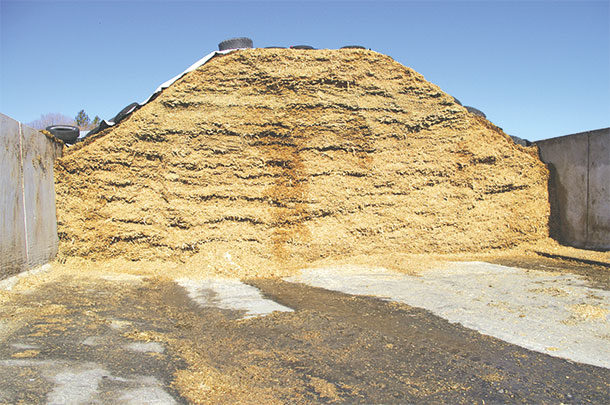Mistakes made during growing and/or harvesting are nearly impossible to rectify and will impact average daily gains, milk production and animal health for months. The steps you and your crew take during silage harvest in the next few weeks will drive your profitability.
The ultimate goal of ensiling is fermentation of the organic matter and the removal of all air. The single-most critical factor affecting silage quality at harvest is the crop moisture level. Research has shown repeatedly that the moisture level when harvesting both corn silage and haylage has the greatest influence on optimal fermentation and dry matter recovery.
Acids matter
The process of ensiling forages – whether corn, grasses or legumes – is not complicated. Once a crop is harvested, chopped and packed, naturally occurring bacteria use the sugars and starches to initiate a fermentation process that uses up the available oxygen, converting part of those sugars and starches into a number of different organic acids that preserve the plant organic matter.
Lactic acid is the strongest and most abundant acid produced in an ideal fermentation, and the presence of lactic acid at a level of 6 to 8 percent of the total dry matter is optimum.
Acetic acid is also present in silage but at lower levels than lactic acid. During fermentation, much of the acetic acid will be converted to lactic acid, and a final ratio of 3-to-1 lactic to acetic acid is desirable. Acetic acid at levels of more than 4 percent of the total dry matter indicates there was a slower fermentation, and if acetic levels are too high, a vinegar odor may be present.
The more quickly lactic acid can be produced, the less chance there will be for dry matter loss or the formation of unwanted organisms such as yeasts and mold. The presence of higher levels of acetic acid in corn silage in and of itself is not necessarily a bad thing. What it indicates, however, is that the silage has probably lost some dry matter due to excessive respiration and the formation of other volatile end products, such as alcohol. Silage that was packed too dry often will have a moldy, musty smell.
Butyric and propionic acids may also be present in the silage. These two acids should never be found in anything greater than trace amounts, if at all. The presence of either of these two acids indicates that lactic acid fermentation is not occurring during the ensiling process. Butyric acid can be especially troublesome, since it can be accompanied by high levels of clostridium (a potentially toxic bacterium) in the silage. Clostridial silages can cause serious rumen upset.
High levels of butyric acid quite often result from the silage being put up too wet, which prevents the pH from dropping quickly enough and affecting the production of the more desirable lactic acid. It can also be present due to poor grain development in the corn crop and, consequently, not enough starch to adequately support proper fermentation. Butyric acid tends to be a greater problem in grass and legume silages since both of those forages are lower in starch content.
Factors that negatively impact quality
Once a plant has been harvested, it immediately begins to decay through a process called respiration. This decaying process is supported and encouraged by the presence of oxygen and bacteria. To keep decomposition (decay) to a minimum, oxygen must be eliminated from the storage environment as quickly as possible. This is accomplished through rapid and aggressive packing at the time of harvesting.

Lingering heat within a pile indicates continued respiration. An inside temperature of a pile of silage climbing above 125ºF is an indication that dry matter is being damaged or destroyed. The anaerobic fermentation process can only occur once the oxygen has been removed. This is a process that, ideally, should not last for more than several days after the pile has been packed. A pH of about 4 is where a well-fermented silage should end up with no noticeable heat being generated from within.
Lactic acid levels in corn silage tend to be the highest and optimal in dry matter ranges from 26 to 32 percent. Silage that is wetter tends to have higher levels of acetic acid relative to the lactic acid levels, which indicates the fermentation process did not proceed as rapidly once the dry matter dropped below 26 percent. Corn silage that is dryer also tends to have lower lactic acid levels as well as a drop in total acids, indicating there is poorer fermentation in dryer corn silage.
For grasses and legumes, rapid fermentation and stabilization will ensure undamaged protein. However, ensiling grasses and legumes can be more challenging because they contain only a fraction of the soluble carbohydrates that corn has, making a good fermentation more difficult. Poorly fermented haylage crops harvested with higher levels of protein will continue to decay, destroying protein quality and leaving residue high in ammonia, which can (in high enough amounts) be toxic to cows, steers and heifers.
Research has shown that the highest lactic acid levels in grass and legume crop silage occur between 32 and 40 percent dry matter. Wetter haylage crops will also produce more butyric acid because the moisture levels produce other, less desirable bacteria that compete with the lactic-acid-producing bacteria.
A second factor that will have a large negative impact on silage quality is the rate at which silages are packed and how quickly the pile is sealed from the air. For all forage crops, getting silage packed as quickly as possible and the use of a silage preservative and sealing the pile or silo as soon as possible will improve the chances of a high-quality silage. A well-packed pile of corn silage should have a density of about 45 to 50 pounds per cubic foot in the pile.
Mitigation opportunities
Serious consideration should be given to using a microbial inoculant on all silages to aid in the fermentation and preservation of the silage dry matter. Significant research has shown that the dry matter recovery in a pile of silage is well worth the dollars invested in an inoculant.
There are a number of inoculants on the market, both dry and liquid. Even if inoculants are not used, it’s critical that the pile or silo is sealed. Silage piles left open to the elements and not covered with a watertight barrier such as plastic will lose many water-soluble nutrients when water percolates down through the pile.
Mechanical processing has been used on corn crops for many years. A dry stand of corn will benefit the greatest from a kernel processor. Processing corn silage improves starch and fiber digestion and allows for good packing in silos even with a longer length of particle chop. Care must be taken, however, in using processors on stands that are too wet since particle size can be made too small, affecting rumen function.
Storage
The type of silage storage environment needs to be well-planned before harvest. Traditionally, upright silos have worked well for smaller herds housed in tiestall or stanchion barns. Larger herds can make good use of horizontal piles and pits. However, these require a much more extensive level of management both in terms of covering and protection from weather and the amount of silage exposure as the pile is fed out.
Piles should be sized so the face can be removed to a depth of 6 inches or more, every day, if possible. Research has shown that air can penetrate over a foot into a pile as the face is exposed. A mechanical facer does a good job of managing the front of large silage piles. Once silage is re-exposed to air, it immediately begins to undergo a secondary fermentation, and the quality will rapidly decrease.
Summary
Feeding costs are the single-largest expense on all livestock operations, and purchasing or growing forages represents a sizable investment. Dry matter and nutrient loss can be significant if silages are not harvested and stored correctly. Proper management of the crucial ensiling process will aid in ensuring a high-quality, highly palatable forage that will feed livestock throughout the year and maximize profitability. ![]()
PHOTO 1: The facing on this silage pile is irregular and allows oxygen into the pile, increasing nutrient loss. The bunker is also poorly designed, providing no place for water and seepage to drain.
PHOTO 2: What not to do: This silage pile was left uncovered and unsealed, allowing grass to sprout across the top layer. Such management practices result in dynamic financial loss. Photos provided by John Hibma.

-
John Hibma
- Consulting Ruminant Nutritionist
- Email John Hibma











